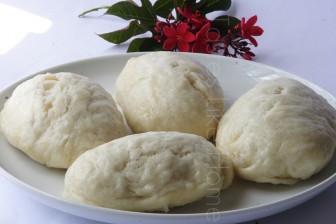Hi Everyone, last month, I received an email from my editor at Stabroek News, in which she relayed the contents of a letter sent to the newspaper. I share that letter with you today and dedicate this edition of the column to the writer of the letter.
Dear Editor,
I buy the Stabroek everyday and on Sundays. I enjoy the recipes that Cynthia Nelson puts in your paper.
My problem is making those nice fluffy dumplings like what our older folks made. I can’t seem to get it right and my husband likes it, so I don’t know if I put too much of baking powder or what.
I would be grateful if she could put the way how to make it in your papers.
Thank you so much.
In 2008, I wrote discussing the two major kinds of dumplings we have – the ones that we put in soups and the duff version which is steamed and eaten with dry food, fried salt fish, callaloo, etc. Like most things that we eat, we each have our preferences. My best bud Sue likes her dumplings hard and chewy, my mom likes hers, soft and fluffy. Some people don’t like dumplings in soup (yours truly). All right stop rolling your eyes and exclaiming that something must be wrong with me! And then there are those among us that if they are having dumplings, it must be the duff version, that is steamed either on top of cooked rice or by itself in a pot.
 The dumplings I am referring to in this article relates to the dumplings cooked separately and not those cooked in a soup or stew. Before I try and get you to nice, fluffy, dumpling heaven, there are some things I need to point out.
The dumplings I am referring to in this article relates to the dumplings cooked separately and not those cooked in a soup or stew. Before I try and get you to nice, fluffy, dumpling heaven, there are some things I need to point out.
The leavening agent
Baking powder is the leavening agent of choice for fluffy dumplings. It is important that the right ratio of baking powder to flour be measured. Too little and the dumpling will not rise adequately; if there’s too much baking powder, then the dumplings will rise and fall. What this means is that there will be too much gas released from the baking powder but not enough gluten (from the flour) for the baking powder to grow, so it will rise, explode and then shrink, making the dumpling hard.
The recommended ratio is 1 cup all-purpose flour to 1 teaspoon baking powder. The cups and spoon measurements I am referring to are standard measuring cups and spoons and not the everyday cups and spoons we use for tea or coffee or eating.
The dough
You want to knead the dough to make it soft and pliable. I have found that adding a little vegetable shortening to the dough aids in keeping it tender when cooked. Once the dough is kneaded, let it rest for at least 30 minutes before cooking. Resting the dough helps the gluten to develop so that it can stretch and remain well structured after cooking.
The cooking

Some people actually boil the dumplings in water, while others steam the dumplings. My preference is steaming the dumplings but by all means, boil it if you like. One of the differences will be the outer texture of the dumplings; the outside will be sticky from the boiling liquid. Steaming will give you a nice uniform texture with little burst spots that you will see from the swelling of the dumplings as they were cooking.
The trickiest part of the dumplings remaining fluffy lies with the cooking time. If the dumplings are cooked for too long, then they will become hard. If they are cooked and allowed to remain in the heated environment – in the hot liquid or covered in the hot pot, then the dumpling will contract and get hard. What I’d suggest is that you remove the pot from the heat first, then raise the lid and remove the dumplings. There should be no deflation, if anything, the outer skin may shrink a little but not enough that it alters the actual texture of the dumpling.
So there are three keys things to pay attention to – the baking powder to flour ratio, the kneading and resting of the dough and the duration of the cooking.
Here’s the recipe. And do let me know how it turns out for you.
Steamed Dumplings
Yield: 4 – 5 round dumplings
Ingredients
2 cups all-purpose flour
2 teaspoons baking powder
2 teaspoons sugar
A pinch of salt
2 teaspoons vegetable shortening
Lukewarm water
Directions
Add the flour, baking powder, sugar and salt to a bowl and mix thoroughly.
Rub in vegetable shortening to flour mixture.
Add enough water to make a soft dough. Once the dough comes together, knead for 2 minutes. Dab a little oil all over the dough and cover and let rest for at least 30 minutes.
Fill a pot with 2 inches of water and then insert a steamer rack. Cover pot and bring to a boil. Meanwhile, divide dough into 4 – 5 equal pieces and form into balls or roll lengthways into oblong – about 2 inches thick and 4 inches wide.
Working in batches (depending on the size and width of your pot), place the dough onto the steamer, cover pot and let cook for 8 – 9 minutes. If steaming on top of rice, cook for 10 – 12 minutes. The times will always vary depending on the size and thickness of the dumplings and how it is being cooked.
Remove from pot and serve as you please.
Note
To avoid the dumplings sticking to the steamer, cut a piece of wax/grease proof paper or parchment paper to the width of the pot, brush it with a little oil and then place the dumplings on the greased paper before transferring to the pot with the steamer. Cut a little whole in the middle of the paper so that the handle of the steamer can slide through easily.
Cynthia
Cynthia@tasteslikehome.org
www.tasteslikehome.org




